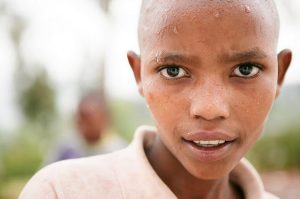
It is widely recognized that art can accomplish broader community goals. Here at the O’Neill Institute, the Health and Human Rights Initiative has been exploring art as a tool for making health and human rights issues more visible and comprehensible. Program Director Alicia Ely Yamin launched Dialogues on Being Human: The Intersections of Art, Health and Dignity with a reflection on this role. At an event with artist Jesse Krimes on February 23, 2017, Yamin stated, “Aspirationally, there is nothing more powerful than art, nothing more powerful than the portrait of one person to convey what is universal about human dignity, much more than a hundred international treaty texts or articles.”
The role of art in social change also drives the Social Documentary Network (SDN), an organization that recently presented the winners of its photo contest Celebrating the Global Community. First place went to photographer John Rae’s The Positive Community, a project that portrays the harsh present and sometimes uncertain future of people living with HIV/AIDS around the world.
The significance of Rae’s project lies in its approach to the needs and realities of people living with HIV/AIDS. Rae does not present a hopeless community, but rather emphasizes the resilience of people living with HIV/AIDS and their families. His project reflects the real difference that outreach and education can make when conducted by peers, especially those living with HIV/AIDS. Underlying the entire project is a call for supportive, peer-based treatment and care where people living with HIV/AIDS are not stigmatized but rather empowered to advance prevention and improve health.
In one of his photographs, a mother with HIV in Cambodia appears with her HIV negative daughter. After transmitting the virus to her first child, she joined an outreach program that taught her how to protect her child from HIV. Rae’s photographs feature vulnerable groups such as sex workers, drug users, inmates, and orphans living with HIV/AIDS, but avoid sensationalism and focus on the different interventions (including food, housing and education) that are working in these communities across the world.
The Positive Community shows the importance of peer education in HIV prevention and, at the same time, the need to move toward a more socially responsible approach to HIV/AIDS in visual arts. Rae stresses in the exhibit abstract that “HIV infection is no longer a death sentence and living with HIV has become an issue of maintenance.”
Almost 30 years have passed since Nicholas Nixon’s photographs of AIDS-affected Tom Moran, which depicted Moran as the Other, someone fragile and cut off from the world. In her book Art About AIDS, author Sophie Junge explains how in Nixon’s project “AIDS is portrayed as the fate of an outsider. The photo arouses horror and fear, but it does not call for political action or social action against the discrimination of people with AIDS.” Decades of progress in HIV/AIDS treatment and prevention allow for contributions like The Positive Community, where a message of hope and support for HIV community outreach can eventually give visibility to the work done by peer educators and have an enhanced impact on people living with HIV/AIDS.
Similarly, yet from a legal perspective, the O’Neill Institute’s Health and Human Rights Initiative and National HIV/AIDS Initiative work to move beyond the traditional approach to academic scholarship to create real-world policy solutions through research in partnership with local, national, and global communities. Our work rests on a collaborative and interdisciplinary approach that brings together diverse stakeholders including many of the groups that Rae’s project presents.
In addition to the Health and Human Rights Initiative’s Dialogues on Being Human, the National HIV/AIDS Initiative is working on the second part of two-part Blueprint for Biomedical HIV Prevention focused on supporting uptake of biomedical HIV prevention modalities for communities of color. The National HIV/AIDS Initiative also has a project exploring how to support uptake of effective HIV prevention and treatment for adolescents and young adults, with a focus on young Black gay and bisexual men, and a new project exploring HIV prevention among Latino gay and bisexual men. Recently, the National HIV/AIDS Initiative has begun to explore the impact of criminal laws and policies on sex workers’ access to HIV prevention and care services and launched its augural HIV/Health Justice Speaker Series, a series of talks for scholars, lawyers, and advocates on the relationship between HIV, health, and criminal justice, including the impact of criminal law on sex workers and people who use drugs. For more information about this work, please check out our webpage.
This blog post was co-authored by Javier Saladich, a Summer Research Intern at the O’Neill Institute. Javier is a third-year law student at ESADE Business and Law School in Barcelona, Spain.



